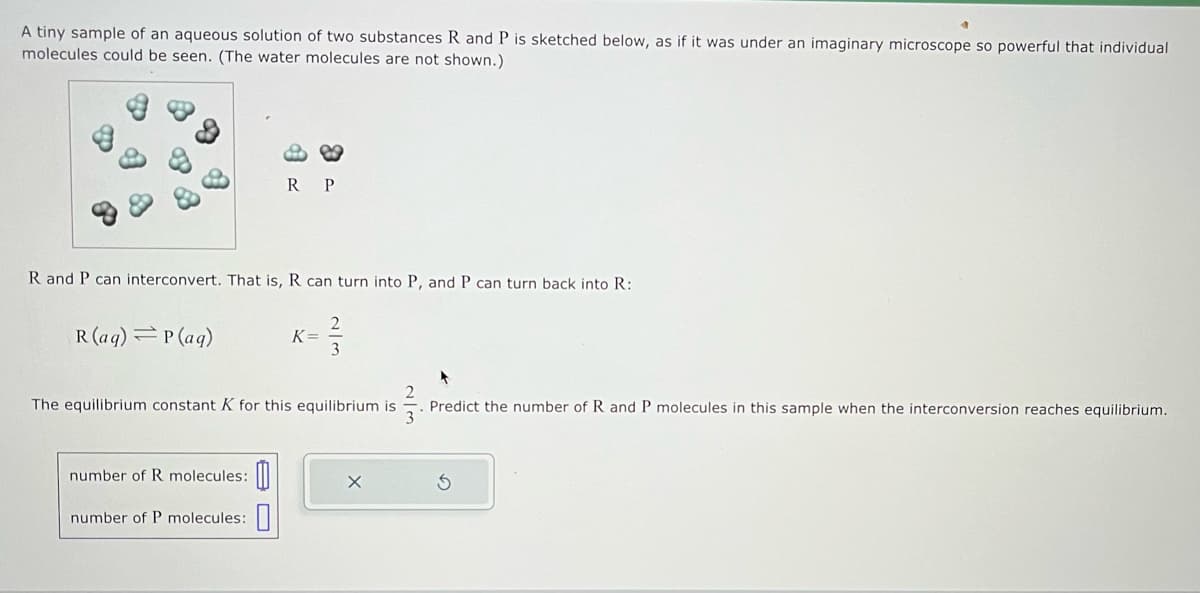A tiny sample of an aqueous solution of two substances R and P is sketched below, as if it was under an imaginary microscope so powerful that individual molecules could be seen. (The water molecules are not shown.) R P R and P can interconvert. That is, R can turn into P, and P can turn back into R: R(aq) P(aq) K 2 3 The equilibrium constant K for this equilibrium is number of R molecules: number of P molecules: Predict the number of R and P molecules in this sample when the interconversion reaches equilibrium. G
A tiny sample of an aqueous solution of two substances R and P is sketched below, as if it was under an imaginary microscope so powerful that individual molecules could be seen. (The water molecules are not shown.) R P R and P can interconvert. That is, R can turn into P, and P can turn back into R: R(aq) P(aq) K 2 3 The equilibrium constant K for this equilibrium is number of R molecules: number of P molecules: Predict the number of R and P molecules in this sample when the interconversion reaches equilibrium. G
General Chemistry - Standalone book (MindTap Course List)
11th Edition
ISBN:9781305580343
Author:Steven D. Gammon, Ebbing, Darrell Ebbing, Steven D., Darrell; Gammon, Darrell Ebbing; Steven D. Gammon, Darrell D.; Gammon, Ebbing; Steven D. Gammon; Darrell
Publisher:Steven D. Gammon, Ebbing, Darrell Ebbing, Steven D., Darrell; Gammon, Darrell Ebbing; Steven D. Gammon, Darrell D.; Gammon, Ebbing; Steven D. Gammon; Darrell
Chapter18: Thermodynamics And Equilibrium
Section: Chapter Questions
Problem 18.124QP: Hydrogen gas and iodine gas react to form hydrogen iodide. If 0.500 mol H2 and 1.00 mol I2 are...
Related questions
Question

Transcribed Image Text:A tiny sample of an aqueous solution of two substances R and P is sketched below, as if it was under an imaginary microscope so powerful that individual
molecules could be seen. (The water molecules are not shown.)
R P
R and P can interconvert. That is, R can turn into P, and P can turn back into R:
R(aq)P(aq)
2
K
3
2
The equilibrium constant K for this equilibrium is
Predict the number of R and P molecules in this sample when the interconversion reaches equilibrium.
3
number of R molecules:
number of P molecules:
G
Expert Solution
This question has been solved!
Explore an expertly crafted, step-by-step solution for a thorough understanding of key concepts.
This is a popular solution!
Trending now
This is a popular solution!
Step by step
Solved in 5 steps with 21 images

Knowledge Booster
Learn more about
Need a deep-dive on the concept behind this application? Look no further. Learn more about this topic, chemistry and related others by exploring similar questions and additional content below.Recommended textbooks for you

General Chemistry - Standalone book (MindTap Cour…
Chemistry
ISBN:
9781305580343
Author:
Steven D. Gammon, Ebbing, Darrell Ebbing, Steven D., Darrell; Gammon, Darrell Ebbing; Steven D. Gammon, Darrell D.; Gammon, Ebbing; Steven D. Gammon; Darrell
Publisher:
Cengage Learning

Introductory Chemistry: A Foundation
Chemistry
ISBN:
9781337399425
Author:
Steven S. Zumdahl, Donald J. DeCoste
Publisher:
Cengage Learning

Principles of Modern Chemistry
Chemistry
ISBN:
9781305079113
Author:
David W. Oxtoby, H. Pat Gillis, Laurie J. Butler
Publisher:
Cengage Learning

General Chemistry - Standalone book (MindTap Cour…
Chemistry
ISBN:
9781305580343
Author:
Steven D. Gammon, Ebbing, Darrell Ebbing, Steven D., Darrell; Gammon, Darrell Ebbing; Steven D. Gammon, Darrell D.; Gammon, Ebbing; Steven D. Gammon; Darrell
Publisher:
Cengage Learning

Introductory Chemistry: A Foundation
Chemistry
ISBN:
9781337399425
Author:
Steven S. Zumdahl, Donald J. DeCoste
Publisher:
Cengage Learning

Principles of Modern Chemistry
Chemistry
ISBN:
9781305079113
Author:
David W. Oxtoby, H. Pat Gillis, Laurie J. Butler
Publisher:
Cengage Learning

Chemistry by OpenStax (2015-05-04)
Chemistry
ISBN:
9781938168390
Author:
Klaus Theopold, Richard H Langley, Paul Flowers, William R. Robinson, Mark Blaser
Publisher:
OpenStax

Chemistry & Chemical Reactivity
Chemistry
ISBN:
9781133949640
Author:
John C. Kotz, Paul M. Treichel, John Townsend, David Treichel
Publisher:
Cengage Learning

Chemistry & Chemical Reactivity
Chemistry
ISBN:
9781337399074
Author:
John C. Kotz, Paul M. Treichel, John Townsend, David Treichel
Publisher:
Cengage Learning